Overview
- Brief Narrative
- Arbeitsjude [Jewish worker] armband number 102616 embroidered with an A in a Star od David worn by Zbyszek Kelhoffer, circa 1941-1943, as a forced laborer in the Beskiden Oil factory camp in German occupied Boryslaw, Poland (Boryslav, Ukraine). When Germany invaded Poland on September 1, 1939, Zbyszek was mobilized into the Polish Army. After a brief campaign, he returned to Soviet occupied Boryslaw. In June 1941, Germany invaded the Soviet Union and Zbyszek was drafted into the Soviet Army. He was captured by the Germans, escaped, and returned home. On July 1, German troops occupied Boryslaw. There was a succession of joint German SS and Ukrainian pogroms killing hundreds of Jews. Zbyszek's wife Sydzia and her mother went into hiding. After Belzec killing center opened in March 1942, 1000s of Boryslaw Jews were deported there. By October 1942, Zbyszek, his parents, and two sisters-in-law were confined in the ghetto. Zbyszek was allowed to leave for work and his worker status probably delayed deportation selection. The ghetto was raided often and many were shot during round-ups. By February 1943, Zbyszek had to move to the slave labor camp. SS and Ukrainian troops moved into the ghetto to eliminate the remaining Jews. His parents were shot. Sydzia and her mother joined her two sisters in hiding in June 1943. Zbyszek joined them in December. The Soviet Army liberated Boryslaw on August 8, 1944. Zbyszek and his family were among only 200 surviving Jews from a population of 12,000. After the war ended in May 1945, Boryslaw was Soviet territory, so they left for Poland.
- Date
-
use:
1942 November-1942 December
- Geography
-
use:
Jewish ghetto;
Boryslav (Ukraine)
- Credit Line
- United States Holocaust Memorial Museum Collection, Gift of Barbara Kelhoffer Bieganiec
- Contributor
-
Subject:
Zbyszek Kelhoffer
- Biography
-
Zbigniew (Zbyszek) Kelhoffer was born on June 13, 1913, in Boryslaw, Poland (Boryslav, Ukraine), to Norbert and Helena Teibels Kelhoffer. His brother, Mieczyslaw (Mitiek), was born in 1920. Norbert was a lawyer. Norbert’s father, Maurycy, had been a surgeon in the Austro-Hungarian Army. Zbyszek studied at the Lvov Polytechnic. In June 1939, the family briefly moved to Vienna, Austria, for Norbert’s job as an attorney for the Matapolska Oil Company. But Helena insisted they return to Boryslaw where Norbert opened a law office. When Germany invaded Poland on September 1, 1939, Zbyszek was mobilized into the Strzelce Podhalanscy, a Polish Army infantry unit. After a brief campaign, he returned to Russian occupied Boryslaw and worked as a clerk at an oil company. On June 22, 1940, he married Sydonia (Sydzia) Pomeranz, whom he had known since high school. Sydzia was born on July 31, 1912, to Bernard and Helena Laudis Pomeranz, born November 25, 1889. Sydzia had two sisters, Julia, born 1908, and Roza, (1916-1973). Sydzia’s family was prosperous; her mother was a civil servant. Sydzia attended pharmacy school in Prague, then studied piano in Vienna. Zbyszek moved in with the Pomeranz family.
In June 1941, Germany invaded the Soviet Union and Zbyszek was drafted into the Soviet Army. He was captured by the Germans, but escaped and returned home. Upon his return, he constructed a hiding space between the family home and the neighbor’s house. On July 1, German troops occupied Boryslaw. The next day, several hundred Jews were murdered in a Ukrainian organized pogrom. This was followed by several joint German SS and Ukrainian attacks to eliminate the Jewish population. In March 1942, the Germans opened Belzec killing center and by summer roughly 5000 Jews had been deported there. In August, the Germans established Beskiden labor camp for workers of the Beskiden Oil Company. Zbyszek worked in the camp and was issued a lapel badge and an armband that allowed him to travel to work. Workers were thought to be protected against deportation. Sydzia went into hiding with her mother in another location, as did Zbyszek’s mother. His father Norbert lived with Zbyszek, along with the two sisters-in-law. The mass deportations continued and several thousand more Jews were deported that fall. By October 13, all Jews were confined to the ghetto and only those with work passes are permitted to leave. There were frequent round-ups during which many were shot. From November to December 1942, Zbyszek wrote daily love letters to Sydzia, mixed with tales of how difficult her sisters were to live with. A woman named Inka sold the family’s belongings for them. There were actions by Jewish policeman who would raid houses, steal what they found, and arrest the inhabitants. Zbyszek’s overseer Skorzyk, a Jewish Council member, did his best to keep his workers protected from deportation, but over 100 were deported. He listed Zbyszek as an electrician, as skilled workers were less likely to be selected. Zbyszek was put on a list to live in the City Council barracks, but then learned that Eduard Goldman, the liaison between the German police and the Jewish Council, had removed his name because he was not a qualified craftsman. Zbyszek’s mother had to leave her cellar hiding place and moved into their building. On December 2, Skorzyk announced that all workers must move into barracks at Beskiden camp in a week. On December 4, Norbert received a postcard from Mitiek telling them he was in a prisoner of war camp and needed food. Zbyszek writes to Sydzia that he is convinced that he will not be able to save his parents. Their apartment is raided again and his father robbed of everything, even his underwear. His father writes a goodbye note in Zbyszek’s letter to Sydzia, giving them his blessing and wishing them a happy, loving life. The only people still living in a hiding place in the basement are a couple, the Birnbaums, and Zbyszek’s mother; the rest have fled or been ordered to the camp barracks. The next day, December 9, Zbyszek, working at the labor camp as deputy to the building site supervisor, learns that the barracks have no water or food. He continued to return to the ghetto at night. The city is a target of bombing raids because of the oilworks.
By February 1943, Jews were no longer allowed to leave the ghetto, even for work. Zbyszek moved to the slave labor camp. SS and Ukrainian police searched the ghetto door to door. Helena and Norbert, with about 600 Jews, were herded into a slaughterhouse and murdered. Sydzia’s sisters, Julia and Roza, had moved to the hiding space previously constructed by Zbyszek at their old home and live there with six other Jews. Sydzia joined her family in hiding in June. Two people allied with the Polish Home Army lived on the ground floor, Karolina Kubrynowa and Jozef, and brought them food. Her sisters did not want Zbyszek to go into hiding with them, as they feared it would increase the probability of discovery. By the end of summer, Boryslaw was emptied of Jews except for the slave laborers at the factory camp. In December, Zbyszek decided to join Sydzia in hiding. When he arrived, his mother-in-law complained about the burden of having another mouth to feed. The factory camp was emptied and destroyed in April-July 1944.
On August 8, 1944, the Soviet Army liberated Boryslaw. Zbyszek, Sydzia, her mother, and sisters were among only 200 Jews from a population of 12,000 to survive. The war ended in Europe on May 8, 1945. Boryslaw became part of the Soviet Union and they moved to Poland. Mietek, Zbyszek’s brother, survived the war and emigrated to the US. Zbyszek and Sydzia settled in Gliwice and a daughter was born on March 17, 1947. Helena, Roza, and Julia emigrated to Israel in 1957. Zbyszek, Sydzia, with their daughter emigrated to Israel in 1968. Sydzia, 74, died in November 1986. Zbyszek, 75, died in 1988.
Physical Details
- Language
- German
- Classification
-
Identifying Artifacts
- Category
-
Armbands
- Object Type
-
Armbands (lcsh)
- Physical Description
- Rectangular, discolored light brown cloth armband with angled corners with a 6-pointed Star of David machine zigzag stitched in gray thread with an A chainstitched in red thread in the center. A number is chainstitched in red thread below the star. There are corroded metal grommets on each side. The long edges are hemmed and the short edges are frayed. The cloth is heavily stained. There is an unattached, black, frayed, and knotted shoelace with corroded metal end tips to insert through the grommets to secure the band to the arm.
- Dimensions
- overall: Height: 4.000 inches (10.16 cm) | Width: 5.875 inches (14.923 cm)
- Materials
- overall : cloth, metal, thread
- Inscription
- front, within star, embroidered, red thread : A [Arbeitsjude (Jewish worker)]
front, below star, embroidered, red thread : 102616
Rights & Restrictions
- Conditions on Access
- No restrictions on access
- Conditions on Use
- No restrictions on use
Keywords & Subjects
Administrative Notes
- Legal Status
- Permanent Collection
- Provenance
- The armband was donated to the United States Holocaust Memorial Museum in 2004 by Barbara Kelhoffer Bieganiec, the daughter of of Sydonia and Zbigniew Kelhoffer.
- Funding Note
- The cataloging of this artifact has been supported by a grant from the Conference on Jewish Material Claims Against Germany.
- Record last modified:
- 2022-11-09 13:12:03
- This page:
- https://collections.ushmm.org/search/catalog/irn516868
Download & Licensing
In-Person Research
- By Appointment
- Request 21 Days in Advance of Visit
- Plan a Research Visit
- Request to See This Object
Contact Us
Also in Sydonia and Zbigniew Kelhoffer family collection
The collection consists of artifacts: armbands, badges, and a wooden box, correspondence, documents, glass and film negatives, and photographs relating to the experiences of Sydonia and Zbigniew Kelhoffer and their families before the Holocaust in Boryslaw, Poland (now Boryslav, Ukraine), and during the Holocaust in the Boryslaw ghetto and Beskiden labor camp, including years when they lived in hiding.
Date: 1914-1957
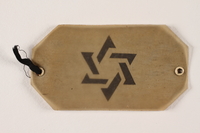
Plastic covered paper armband with a cut out Star of David worn in the Boryslaw ghetto
Object
Paper armband with a stencilled cut out Star of David worn by Zbyszek Kelhoffer circa 1941-1943 as a forced laborer in the Beskiden Oil factory camp in German occupied Boryslaw, Poland (Boryslav, Ukraine). When Germany invaded Poland on September 1, 1939, Zbyszek was mobilized into the Polish Army. After a brief campaign, he returned to Soviet occupied Boryslaw. In June 1941, Germany invaded the Soviet Union and Zbyszek was drafted into the Soviet Army. He was captured by the Germans, escaped, and returned home. On July 1, German troops occupied Boryslaw. There was a succession of joint German SS and Ukrainian pogroms killing hundreds of Jews. Zbyszek's wife Sydzia and her mother went into hiding. After Belzec killing center opened in March 1942, 1000s of Boryslaw Jews were deported there. By October 1942, Zbyszek, his parents, and two sisters-in-law were confined in the ghetto. Zbyszek was allowed to leave for work and his worker status probably delayed deportation selection. The ghetto was raided often and many were shot during round-ups. By February 1943, Zbyszek had to move to the slave labor camp. SS and Ukrainian troops moved into the ghetto to eliminate the remaining Jews. His parents were shot. Sydzia and her mother joined her two sisters in hiding in June 1943. Zbyszek joined them in December. The Soviet Army liberated Boryslaw on August 8, 1944. Zbyszek and his family were among only 200 surviving Jews from a population of 12,000. After the war ended in May 1945, Boryslaw was Soviet territory, so they left for Poland.
![Plastic covered Rustung [Armament] badge worn by a Polish Jewish worker in Beskiden labor camp Plastic covered Rustung [Armament] badge worn by a Polish Jewish worker in Beskiden labor camp](https://www.ushmm.org/media/emu/get?irn=516872&mm_irn=15466&file=secondary)
Plastic covered Rustung [Armament] badge worn by a Polish Jewish worker in Beskiden labor camp
Object
Badge with an R for Rustung [Armament Worker] worn by Zbyszek Kelhoffer, circa 1941-1943, as a forced laborer in the Beskiden oil factory camp in German occupied Boryslaw, Poland (Boryslav, Ukraine). When Germany invaded Poland on September 1, 1939, Zbyszek was mobilized into the Polish Army. After a brief campaign, he returned to Soviet occupied Boryslaw. In June 1941, Germany invaded the Soviet Union and Zbyszek was drafted into the Soviet Army. He was captured by the Germans, escaped, and returned home. On July 1, German troops occupied Boryslaw. There was a succession of joint German SS and Ukrainian pogroms killing hundreds of Jews. Zbyszek's wife Sydzia and her mother went into hiding. After Belzec killing center opened in March 1942, 1000s of Boryslaw Jews were deported there. By October 1942, Zbyszek, his parents, and two sisters-in-law were confined in the ghetto. Zbyszek was allowed to leave for work and his worker status probably delayed deportation selection. The ghetto was raided often and many were shot during round-ups. By February 1943, Zbyszek had to move to the slave labor camp. SS and Ukrainian troops moved into the ghetto to eliminate the remaining Jews. His parents were shot. Sydzia and her mother joined her two sisters in hiding in June 1943. Zbyszek joined them in December. The Soviet Army liberated Boryslaw on August 8, 1944. Zbyszek and his family were among only 200 surviving Jews from a population of 12,000. After the war ended in May 1945, Boryslaw was Soviet territory, so they left for Poland.
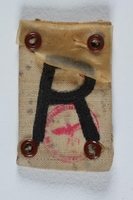
Badge with an R for Rustung (Armament) worn by a Polish Jewish worker in Beskiden labor camp
Object
Badge with an R for Rustung (Armament Worker) worn by Zbyszek Kelhoffer, circa 1941-1943, as a forced laborer in the Beskiden Oil factory camp in German occupied Boryslaw, Poland (Boryslav, Ukraine). When Germany invaded Poland on September 1, 1939, Zbyszek was mobilized into the Polish Army. After a brief campaign, he returned to Soviet occupied Boryslaw. In June 1941, Germany invaded the Soviet Union and Zbyszek was drafted into the Soviet Army. He was captured by the Germans, escaped, and returned home. On July 1, German troops occupied Boryslaw. There was a succession of joint German SS and Ukrainian pogroms killing hundreds of Jews. Zbyszek's wife Sydzia and her mother went into hiding. After Belzec killing center opened in March 1942, 1000s of Boryslaw Jews were deported there. By October 1942, Zbyszek, his parents, and two sisters-in-law were confined in the ghetto. Zbyszek was allowed to leave for work and his worker status probably delayed deportation selection. The ghetto was raided often and many were shot during round-ups. By February 1943, Zbyszek had to move to the slave labor camp. SS and Ukrainian troops moved into the ghetto to eliminate the remaining Jews. His parents were shot. Sydzia and her mother joined her two sisters in hiding in June 1943. Zbyszek joined them in December. The Soviet Army liberated Boryslaw on August 8, 1944. Zbyszek and his family were among only 200 surviving Jews from a population of 12,000. After the war ended in May 1945, Boryslaw was Soviet territory, so they left for Poland.
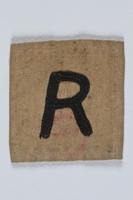
Cloth badge with an R for Rustung (Armament) worn by a Polish Jewish worker in Beskiden labor camp
Object
Cloth badge with an R for Rustung (Armament) worn by Zbyszek Kelhoffer circa 1941-1943 as a forced laborer in the Beskiden Oil factory camp in German occupied Boryslaw, Poland (Boryslav, Ukraine). When Germany invaded Poland on September 1, 1939, Zbyszek was mobilized into the Polish Army. After a brief campaign, he returned to Soviet occupied Boryslaw. In June 1941, Germany invaded the Soviet Union and Zbyszek was drafted into the Soviet Army. He was captured by the Germans, escaped, and returned home. On July 1, German troops occupied Boryslaw. There was a succession of joint German SS and Ukrainian pogroms killing hundreds of Jews. Zbyszek's wife Sydzia and her mother went into hiding. After Belzec killing center opened in March 1942, 1000s of Boryslaw Jews were deported there. By October 1942, Zbyszek, his parents, and two sisters-in-law were confined in the ghetto. Zbyszek was allowed to leave for work and his worker status probably delayed deportation selection. The ghetto was raided often and many were shot during round-ups. By February 1943, Zbyszek had to move to the slave labor camp. SS and Ukrainian troops moved into the ghetto to eliminate the remaining Jews. His parents were shot. Sydzia and her mother joined her two sisters in hiding in June 1943. Zbyszek joined them in December. The Soviet Army liberated Boryslaw on August 8, 1944. Zbyszek and his family were among only 200 surviving Jews from a population of 12,000. After the war ended in May 1945, Boryslaw was Soviet territory, so they left for Poland.
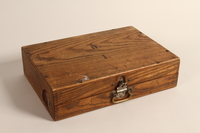
Wooden box with inlaid initials used by a Polish Jew in hiding in the Boryslaw ghetto
Object
Handmade wooden box used by Zbyszek Kelhoffer to store personal items in the Jewish ghetto in Boryslaw, Poland (Boryslav, Ukraine), 1941-1945. The box had belonged to his grandfather, Maurycy, a surgeon, who used it to store his surgical instruments. From 1941-1943, Zbyszek was a forced laborer in the Beskiden Oil factory camp in German occupied Boryslaw, Poland (Boryslav, Ukraine). When Germany invaded Poland on September 1, 1939, Zbyszek was mobilized into the Polish Army. After a brief campaign, he returned to Soviet occupied Boryslaw. In June 1941, Germany invaded the Soviet Union and Zbyszek was drafted into the Soviet Army. He was captured by the Germans, escaped, and returned home. On July 1, German troops occupied Boryslaw. There was a succession of joint German SS and Ukrainian pogroms killing hundreds of Jews. Zbyszek's wife Sydzia and her mother went into hiding. After Belzec killing center opened in March 1942, 1000s of Boryslaw Jews were deported there. By October 1942, Zbyszek, his parents, and two sisters-in-law were confined in the ghetto. Zbyszek was allowed to leave for work and his worker status probably delayed deportation selection. The ghetto was raided often and many were shot during round-ups. By February 1943, Zbyszek had to move to the slave labor camp. SS and Ukrainian troops moved into the ghetto to eliminate the remaining Jews. His parents were shot. Sydzia and her mother joined her two sisters in hiding in June 1943. Zbyszek joined them in December. The Soviet Army liberated Boryslaw on August 8, 1944. Zbyszek and his family were among only 200 surviving Jews from a population of 12,000. After the war ended in May 1945, Boryslaw was Soviet territory, so they left for Poland.
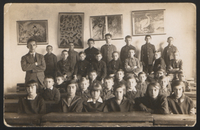
Kelhoffer and Pomeranz families papers
Document
The Kelhoffer and Pomeranz families papers comprise documents and photographs concerning Zbigniew Kelhoffer, his wife, Sydonia Pomeranz and their families in Borysław, Poland during the Holocaust. The collection contains identification cards, correspondence, pre and post-war photographs of both families, and a series of diaries written by Zbyszek during his imprisonment in the Borysław ghetto in 1942 and sent to his wife in hiding. Kelhoffer and Pomeranz families papers contain documents and photographs concerning the Kellhoffers’ and Pomeranz’ experiences in the years immediately before World War II, during, and after. The collection is arranged by family and family member thereunder. Materials documenting the Kellhoffer family include diaries written by Zbyszek during his imprisonment in the Borysław ghetto and sent to his wife Sydzia, who was in hiding at that time in 1942. The entries are addressed to her and discuss his situation as a forced laborer in the ghetto, his mood, and relays news regarding her family. Also included are several of Zbyszek’s identification cards, a couple of which were issued by the Germans during the war, and photographs depicting Zbyszek before and after the war. Materials pertaining to Zbyszek’s uncle, Oskar are also comprised here within, as is a photograph of his mother, Helena and a letter from her written on the occasion of his wedding day in 1940. Materials pertaining to the Pomeranz family include identification cards for and photographs of Sydzia and her sisters, Roza and Julia. A class register from Charles University in Prague, an employment history book belonging to Sydzia and her marriage certificate is also comprised in this collection. Among the material regarding Julia is a series of correspondence regarding the custody of a child in 1950.
![Plastic covered Arbeitsjude [Jewish worker] armband, number 102866 worn in the Boryslaw ghetto Plastic covered Arbeitsjude [Jewish worker] armband, number 102866 worn in the Boryslaw ghetto](https://www.ushmm.org/media/emu/get?irn=516867&mm_irn=15246&file=secondary)
Plastic covered Arbeitsjude [Jewish worker] armband, number 102866 worn in the Boryslaw ghetto
Object
Arbeitsjude [Jewish worker] armband number 102866 with an embroidered A in a Star of David worn by Zbyszek Kelhoffer, circa 1941-1943, as a forced laborer in the Beskiden Oil factory camp in German occupied Boryslaw, Poland (Boryslav, Ukraine). When Germany invaded Poland on September 1, 1939, Zbyszek was mobilized into the Polish Army. After a brief campaign, he returned to Soviet occupied Boryslaw. In June 1941, Germany invaded the Soviet Union and Zbyszek was drafted into the Soviet Army. He was captured by the Germans, escaped, and returned home. On July 1, German troops occupied Boryslaw. There was a succession of joint German SS and Ukrainian pogroms killing hundreds of Jews. Zbyszek's wife Sydzia and her mother went into hiding. After Belzec killing center opened in March 1942, 1000s of Boryslaw Jews were deported there. By October 1942, Zbyszek, his parents, and two sisters-in-law were confined in the ghetto. Zbyszek was allowed to leave for work and his worker status probably delayed deportation selection. The ghetto was raided often and many were shot during round-ups. By February 1943, Zbyszek had to move to the slave labor camp. SS and Ukrainian troops moved into the ghetto to eliminate the remaining Jews. His parents were shot. Sydzia and her mother joined her two sisters in hiding in June 1943. Zbyszek joined them in December. The Soviet Army liberated Boryslaw on August 8, 1944. Zbyszek and his family were among only 200 surviving Jews from a population of 12,000. After the war ended in May 1945, Boryslaw was Soviet territory, so they left for Poland.



